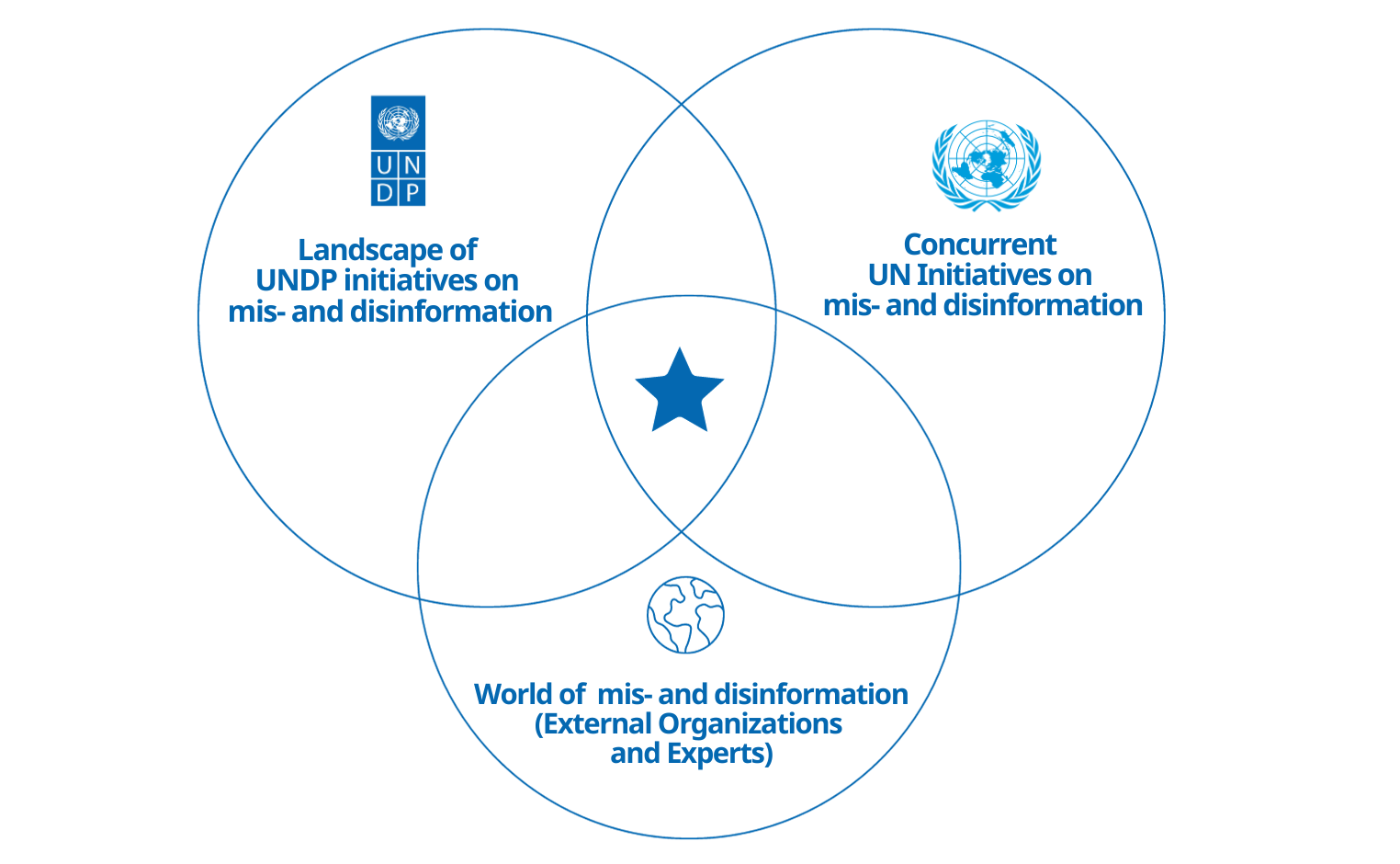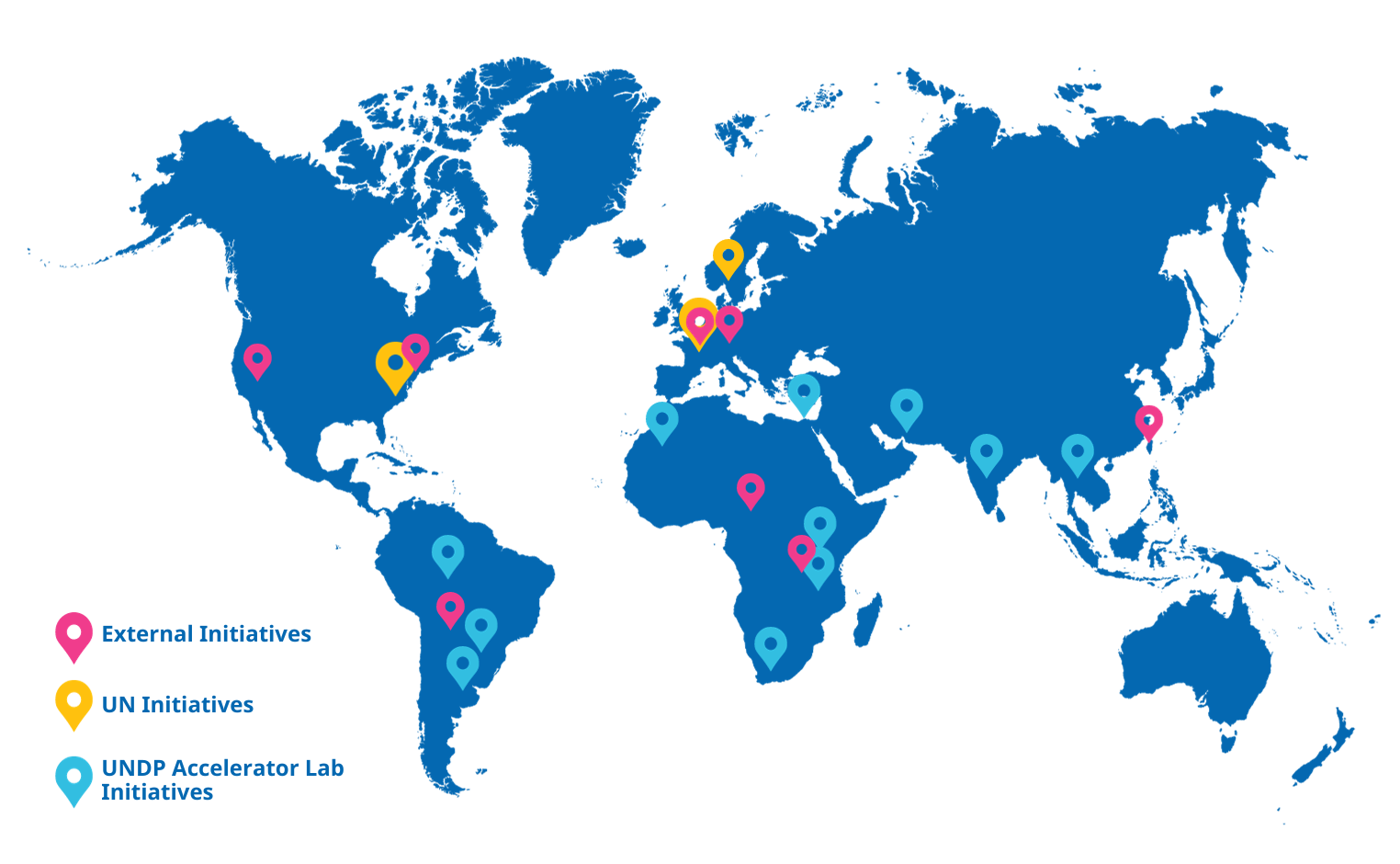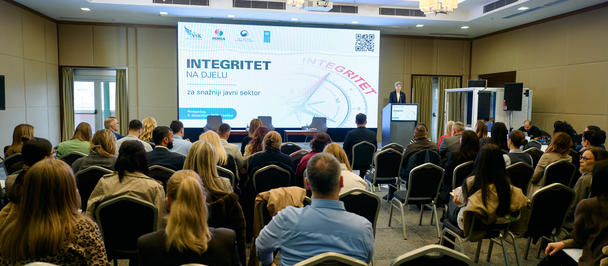How UNDP is Fighting Mis- and Disinformation: Mapping the Innovations, Recommending Solutions
November 7, 2023

Guest blog by: Audrey Hatfield, Khatdija Meghjani, Jason Williams-Bellamy, Danial Saiyid, Jiayu Zhou and Dr. Anya Schiffrin, School of International and Public Affairs at Columbia University
Mis- and disinformation is a global problem which undermines good governance and trust. The rapid and pervasive spread of mis- and disinformation across the globe threatens to erode our information ecosystems and disrupt progress on the Sustainable Development Goals. It can do this by amplifying polarization and divisions in times of emergency, crisis, key political moments or armed conflict. It deeply affects policymaking and consensus on issues of public interest and concern. The problem is explosive: an estimated 5.3 billion people, or 66 percent of the world’s population use the Internet to access information as of 2022 and more than 80 percent own a smartphone, meaning the reach of online mis- and disinformation is climbing to unprecedented levels. In addition, new technologies like language processing models as well as AI-generated deepfakes and algorithms are increasingly used to spread targeted disinformation while efforts to combat highly sophisticated mis- and disinformation are slow to keep up.
Mis- and disinformation undermines good governance practices, disrupts confidence in full and fair elections and inhibits the green transition. Some examples can be found in the Europe and Central Asia Region: the 2022 elections in Bosnia and Herzegovina were marred by the spread of false information about political candidates. Gendered disinformation has been used as a tool to undermine democratic values in Moldova, and in Ukraine, the war has been accompanied by a flood of propaganda and disinformation from its onset.
Mapping already existing innovations
We’re a team of Columbia University students who just graduated from the School of International and Public Affairs (SIPA) in New York. For our capstone project, led by Anya Shiffrin, director of the Technology, Media, and Communications specialization at SIPA, we spent six months mapping how the UNDP Accelerator Labs are combatting online mis- and disinformation and how these efforts complement what other organizations, inside and outside the United Nations are doing.
We set out to map and analyze all these interventions and offer recommendations on how to improve coordination across Labs and the United Nations in this newly released report: Mapping and Recommendations for UNDP Efforts to Fight Against Mis- and Disinformation.

We analyzed all existing interventions -- both within the United Nations system and from external partners around the world and clustered them in a portfolio of three main categories of solutions addressing mis- and disinformation in the Global South.

Figure 1: A map of the most successful innovative solutions found in the portfolio
A taxonomy of solutions: from the supply side to the demand side of the information value chain
The SIPA Team categorized solutions for mis- and disinformation using Dr. Anya Schiffrin’s proprietary taxonomy of solutions.
Supply-side solutions emphasize the supply of information and refer to controlling what information is shown through algorithms and content moderation. The supply-side solutions can be further broken down into two parts: 1) suppressing poor quality/dangerous or illegal information and 2) creating and/or promoting high-quality information.
Demand-side solutions emphasize the role of the consumers, and include efforts to teach media literacy, promote community engagement, and verification efforts such as labeling and fact-checking. These solutions emphasize audience demand and the role of individual choice.
In our below taxonomy, you can find a selection of solutions mapped and categorized by their relevance in this information value chain:
Supply-side solutions
| Project | Location(s) | Organization(s) |
|---|---|---|
| Public-Private Partnerships to Provide Quality Information | Pakistan | UNDP |
| Guidelines for Regulating Digital Platforms | Paris | UNESCO |
| Global Digital Compact | New York | United Nations |
| Digital Public Goods Campaign | New York | United Nations |
| Content Regulation | Germany, Europe | Federal Republic of Germany, European Union |
| Age Restrictions on Digital Media Platforms | United States, Utah | YouTube, Meta, State of Utah |
Demand-side solutions
| Project | Location(s) | Organization(s) |
|---|---|---|
| Media Literacy Training | Kenya, Togo, Morocco, South Africa, Argentina, Lebanon, Uruguay | UNDP Accelerator Labs, UNDP Governance Team |
| Gamified Media Literacy | India, Timor-Leste, Cabo Verde, Morocco | UNDP Accelerator Labs |
| Crowdsourced Content Moderation | Argentina, Kenya, Lebanon, Morocco, Togo, Sudan, Iraq, Namibia | UNDP Accelerator Labs, TED |
| Paid ad campaigns | Kenya | UNDP, Google |
| Advocacy | South Africa | UNDP |
| Automated Information Tracking | Tanzania, Uruguay | UNDP |
| Business Challenges | Cambodia | UNDP |
| iVerify | Global | UNDP |
| eMonitor+ | Global | UNDP |
| Hyperlocal community Engagement | United States, Kenya | Aga Khan University |
| Fund grassroot journalisms | Global | Internews |
| Centralized Content Moderation | Kenya | Communications Authority of Kenya, Media Council of Kenya, National Cohesion and Integration Commission |
| Fact Checking | Africa, Latin America, United States | AfricaCheck, Factchequeado, PesaCheck |
Finally, we traveled to Nairobi and Buenos Aires to meet with dozens of experts on mis- and disinformation and interviewed experts in New York. It is clear there are many groups working to fix the thorny problem of mis- and disinformation and local context is key.
For example, we were inspired by the commitment to democracy in Argentina that appeared to influence how organizations seek to educate citizens on the dangers of mis- and disinformation, as well as how citizens engage with it. In fact, the UNDP Accelerator Labs in the Latin American region looked closely at mis- and disinformation in eight countries: Argentina, Bolivia, Colombia, Dominican Republic, Guatemala, Panama, Peru, and Uruguay, seeking innovative ways to turn off the taps of false information flows. They learned that efforts to combat misinformation require complementary investments to close information gaps and that there is untapped potential in participatory bottom-up approaches to address misinformation.
Our research identifies critical gaps where UNDP can support in fighting mis- and disinformation, particularly in the Global South. Two main types of gaps were found:
- "response gaps," which include a lack of offline solutions to mis- and disinformation and insufficient coordination among United Nations initiatives at the national level,
- and "environmental gaps," which encompass the imbalanced regulatory power in the Global South and the sophisticated nature of the mis- and disinformation ecosystem. For example, identifying local influential voices is key in places where citizens rely on trusted community leaders or religious figures to inform them of problems. There may also be instances of offline mis- and disinformation affecting smaller, rural communities such as through radio broadcasts. In these cases, the problems should be addressed in a different way than online dissemination.
In particular, new legislation is rolling out to address the negative effects of digital platforms. Legislation such as the EU’s Digital Services Act takes into account the environmental gap resulting from the imbalance of regulatory power in the Global South, which is essential for developing safe solutions to mis- and disinformation. While some countries will look for state-funded entities to regulate, smaller countries may not be able to clash with large and wealthy tech platforms. There is also the risk of authoritarian regimes co-opting regulation to censor or curtail fundamental human rights.
With all of this in mind, our team recommends that the UNDP Accelerator Labs be used to enhance efforts to combat mis- and disinformation on a local level. While there are a number of global UN and UNDP initiatives underway to strengthen information integrity, the experts we spoke with asked for more coordination across these initiatives at a local and regional level so that efforts are not duplicative. The UNDP Accelerator Labs Network also provides an excellent opportunity to test hyperlocal solutions and can be used to build a better understanding of how a trusted voice in a community can be leveraged to limit the spread of mis- and disinformation.
For a closer look at our analysis and recommendations, read our report: Mapping and Recommendations for UNDP efforts to Fight Against Mis- and Disinformation.
Thanks to the UNDP Argentina and Kenya Accelerator Lab teams, the UNDP Argentina Leadership team, Natalia Aruguete, Rosaura Audi, Saleha Awal, Savita Bailur, Felicitas Carrique, Roly Davila, Joan Donovan, James Fahn, Alison Go, Eduardo Gustale, Martín Guzmán, Tamar Hanh, Suzanne Hollman, Niamh Hanafin, Philip Howard, Sarah Lister, Damián Loreti, Gina Lucarelli, Mora Matassi, Jenny McGill, Eric Mugendi, Rosemary Mwaga, Lilian Njoro, Liz Orembo, Hesbon Owilla, Alykhan Peermohamed, Diego Rossi, Jane Serwanga, Olivia Sohr, Natalia Vinelli, Ilona Virk, and Laura Zommer.

 Locations
Locations



